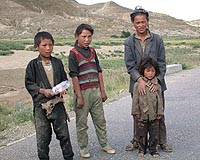 |
Alice Springs, Australia (UPI) Jun 18, 2009 Australians are being urged to eat a camel to save the country's desert resources that are even scarcer because of continuing drought conditions. An academic from Charles Darwin University wants people to develop a taste for wild camel meat and dine on it at least once every two weeks, a report in the Courier Mail newspaper stated. This would cut down on the more than 1 million feral camels roaming Australia's central desert regions eating vegetation at watering holes and despoiling the water itself, said lecturer Peter Dempster. Camels were imported into Australia in the 1840s, but stud farms developed indigenous varieties that worked well in Australian conditions. Many were used as draft and riding animals by pioneers. Telegraph and mining camps also used camels, while local aboriginal stud men helped capture, train and breed them. The state of Western Australia has around half the population, with the rest in the Northern Territory, Western Queensland and South Australia. But their numbers are expected to double every nine years, causing concern among environmentalists. A major report from the environmental research organization Desert Knowledge CRC late last year considered ways of managing the camels that included culling and as well as eating them. It noted the damages that the camels do especially to the aboriginal communities because they are the people most often living in the isolated rural areas. Camels might also aid in the spread of diseases such as bluetongue, Rinderpest, Rift valley fever and bovine tuberculosis. The issue is important because of the long-range forecast for Australia's desert areas to 2030. A temperature increase of at least 1 degree Celsius and more hot days will exacerbate the damage that camels do, the report noted. Camels will move onto more cultivated land to seek food and water. Australia's drought is expected to continue, the latest estimates from Australia's Climate Prediction Center indicate. It has issued an El Nino alert that points to a possible drought in the main wheat states of New South Wales and Victoria. The El Nino effect occurs when sea surface temperatures rise in the central Pacific Ocean and wind patterns shift. Australia's wheat harvests were half the normal rates in the El Nino years of 2002 and 2006. Share This Article With Planet Earth
Related Links Farming Today - Suppliers and Technology
 Climate change hits China's poor hardest: activist groups
Climate change hits China's poor hardest: activist groupsBeijing (AFP) June 17, 2009 Climate change hits China's poor the hardest and also forces some of those lifted out of hardship back into it, activist groups Greenpeace and Oxfam said Wednesday. The two urged the Chinese government to review its existing poverty alleviation policy to take climate change into account, in a report compiled with experts from the nation's Academy of Agricultural Sciences. "Climate change ... read more |
|
| The content herein, unless otherwise known to be public domain, are Copyright 1995-2009 - SpaceDaily. AFP and UPI Wire Stories are copyright Agence France-Presse and United Press International. ESA Portal Reports are copyright European Space Agency. All NASA sourced material is public domain. Additional copyrights may apply in whole or part to other bona fide parties. Advertising does not imply endorsement,agreement or approval of any opinions, statements or information provided by SpaceDaily on any Web page published or hosted by SpaceDaily. Privacy Statement |